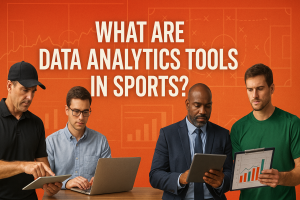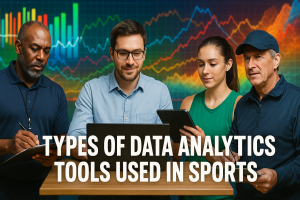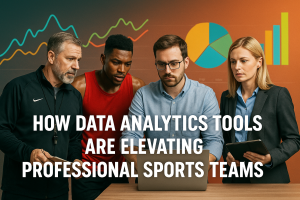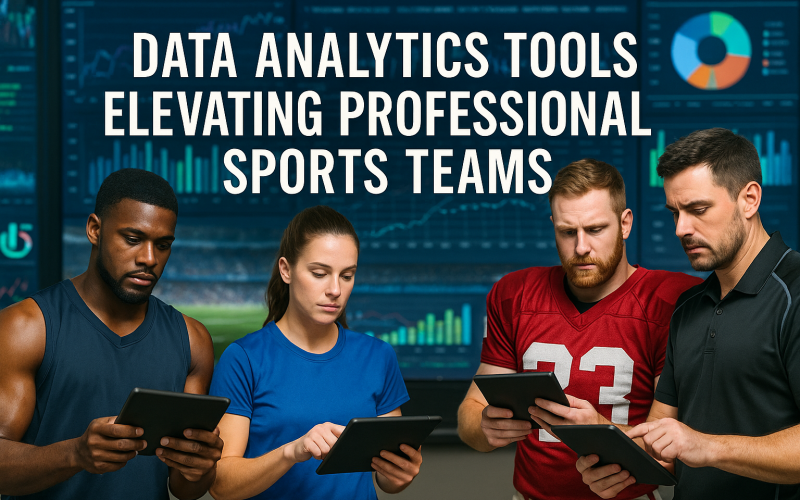Introduction
In the world of professional sports, success often comes down to the smallest details. From player performance to game strategies, teams are always looking for an edge to outperform their competition. Data analytics tools have become a game-changer in how teams analyze and improve their performance. These tools provide valuable insights into every aspect of the game, allowing teams to make more informed decisions both on and off the field.
In this article, we’ll explore how data analytics tools are transforming professional sports teams, helping them gain a wide range competitive advantage. From tracking player performance to optimizing game strategies, data analytics is now an essential part of sports management and team success.
What Are Data Analytics Tools in Sports?

Data analytics tools in sports refer to software and technologies that help teams collect, process, and analyze vast amounts of data analysts to improve performance data. These tools use advanced algorithms, statistical models, and real-time data to give teams a deeper understanding of their strengths and weaknesses.
At the core of sports analytics is the idea of using data to make decisions that were once based on intuition or experience alone. These tools can analyze everything from player movements, game strategies, and injury risks to provide actionable insights that can significantly improve team performance.
Types of Data Analytics Tools Used in Sports

There are several types of data analytics tools that professional sports teams rely on to elevate their game. These include:
- Performance Analysis Tools: These tools track player metrics like speed, distance, accuracy, and reaction times during games and training sessions.
- Video Analysis Tools: These tools analyze game footage to identify patterns, weaknesses, and opportunities for improvement in both players and teams.
- Injury Prevention Tools: Using data to predict and prevent injuries by monitoring player workload, physical stress, and recovery.
- Game Strategy Analysis Tools: These tools help coaches and managers design effective game strategies by analyzing historical data, opponent weaknesses, and environmental factors.
Benefits of Data Analytics for Teams and Athletes
Data analytics brings clear gains to both players and coaching staff. Coaches can spot early signs of fatigue or injury risk by tracking load and movement patterns, then adjust training schedules before problems start. Players receive personalized feedback on their speed, positioning, and technique, helping them refine skills faster than ever before. Teams gain tactical insights by studying opponent tendencies and finding weak spots. Over the course of a season, these small, data-driven tweaks add up to fewer injuries, sharper strategies, and better results on the field or court.
Role of Analytics in Training, Scouting, and Strategy

Analytics now shapes every stage of a club’s operation, from daily practice drills to transfer decisions. In training, software flags when athletes exceed safe workloads and suggests rest or modified sessions. Scouts use performance models to identify promising talent who fit the team’s style, even in distant leagues. Match analysts break down video to recommend tactical shifts midgame, such as changing formations based on opponent patterns. Even nutritionists and mental coaches tap into data dashboards to tailor meal plans and mental exercises. This integration turns data into a shared language that guides every decision.
How Data Analytics Tools Are Elevating Professional Sports Teams

Data analytics is revolutionizing the way professional sports teams operate. Below, we’ll look at several key areas where data analytics tools are making a significant impact.
1. Player Performance Optimization
One of the biggest advantages of data analytics tools is the ability to optimize player performance. By tracking key metrics such as speed, agility, strength, and endurance, coaches and trainers can develop personalized training plans to help players improve in specific areas.
For example, the NBA uses player tracking technology to monitor a player’s movement during a game. This data allows coaches to identify areas where a player’s performance can improve, such as their shooting accuracy or defensive positioning. It also helps identify the best tactics for utilizing the player’s strengths.
2. Injury Prevention and Recovery
Injuries are a major concern for professional sports teams, and data analytics tools are helping to reduce their frequency and impact. By analyzing data from wearable devices, teams can monitor players’ physical conditions in real time. This data helps medical staff assess injury risks and implement preventive measures.
For example, a soccer team might use wearable technology to monitor the amount of distance a player runs and the intensity of their movements. If a player is at risk of injury due to overexertion, the team can adjust their training schedule or give them rest to avoid a potential injury.
3. Improving Game Strategy
Game strategy analysis is another area where data analytics plays a crucial role. Coaches and managers use data to analyze the strengths and weaknesses of both their team and their opponents. By studying data from previous games, coaches can identify patterns and create strategies that increase the team’s chances of winning.
For example, football teams use data to analyze their opponents’ past games, looking for patterns in playmaking and defensive setups. This allows them to develop tailored strategies that exploit the opponent’s weaknesses, whether it’s targeting a specific player or exploiting a vulnerable area on the field.
4. Fan Engagement and Experience
The impact of data analytics tools isn’t limited to the players and coaches. Professional sports teams are also using data to enhance the fan experience. Teams collect data on fan behavior and preferences, which helps them improve everything from ticket pricing to personalized marketing strategies and fan engagement efforts.
For example, sports organizations are using data to predict which games will attract the most fans, helping them optimize their marketing efforts. By using customer data, teams can create personalized experiences for fans, such as offering special promotions or VIP access to certain events.
5. Scouting and Recruitment
Data analytics tools have also changed how professional sports teams scout and recruit new players. In the past, scouting was often based on intuition or limited data. Now, teams use sophisticated data analytics to evaluate potential recruits. These tools analyze a player’s performance metrics, behavior, and physical attributes to predict how they will perform on the team.
For example, baseball teams use data analytics tools like sabermetrics to evaluate potential players’ performance based on objective statistics. This method is much more reliable than subjective judgments, allowing teams to make more informed decisions about who to sign.
Tips for Implementing Data Analytics in Professional Sports Teams

1. Invest in the Right Tools
The right data analytics tools can provide actionable insights, but it’s important to choose the tools that align with the team’s needs. From performance analysis to injury prevention, teams should invest in the tools that will provide the most value.
2. Ensure Data Accuracy
The effectiveness of data analytics tools depends on the quality of the data collected. Teams must ensure that the data they are collecting is accurate and reliable, as incorrect data could lead to poor decision-making.
3. Train Staff and Players
It’s not enough to just have the tools. Teams must also invest in training staff and players to understand and use the data. This will help them make informed decisions and take full advantage of the insights offered by the tools.
4. Continuously Analyze and Adjust
The world of sports is dynamic, and data analytics is no different. Teams should continuously analyze new data and adjust their strategies and training methods based on the findings. The key is to stay flexible and open to making changes when necessary.
Challenges of Using Data Analytics in Sports
Despite its promise, analytics faces real hurdles in the sports world. Collecting high-quality, consistent data requires expensive sensors, cameras, and technical support that small clubs may struggle to afford. Interpreting vast datasets demands skilled analysts, a role where talent remains scarce. Overreliance on numbers can overlook human factors like morale or locker-room chemistry. Privacy rules around personal health data require careful handling to protect athletes’ rights. Finally, integrating analytics into fast-paced team cultures means coaches and players must trust and adopt new tools, which can take time and training.
Future of Sports Analytics

The next frontier of real-time sports data lies in enhanced AI and machine learning. As computing power grows, models will predict injuries days before they happen. Augmented reality (AR) and virtual reality (VR) will bring data overlays to live broadcasts and training sessions. Fans may choose their own camera angles with instant stat updates, while coaches make split-second decisions using voice-activated analytics tools.
Athlete-centric wearables will shrink further, becoming embedded in uniforms. Continuous biomarker tracking could measure hydration levels, sleep quality, and stress, all feeding into holistic performance profiles. The fusion of genomics and predictive analytics may personalize training to an athlete’s DNA. In this evolving landscape, sports data analytics will shift from a competitive advantage to a baseline requirement for all elite teams.
Comparative Table: Popular Data Analytics Tools Used in Professional Sports
| Tool | Purpose | Sports | Key Features |
|---|---|---|---|
| STATS SportVU | Player and team performance tracking | Basketball, Football | Player movement tracking, shot analysis |
| Catapult Sports | Player monitoring and injury prevention | Soccer, Rugby, Basketball | Wearable tech for fitness tracking |
| Sportscode | Video analysis and game breakdown | All sports | Game footage analysis, tactical feedback |
| Zebra Technologies | Real-time player tracking | Football, Hockey, Soccer | Real-time data collection, positional tracking |
| Krossover | Game film analysis and performance data | Basketball, Football, Baseball | Video breakdown, detailed game analysis |
Conclusion
Data analytics tools are transforming professional sports teams by providing deeper insights into player performance, game strategies, and even fan engagement. By leveraging these tools, teams can make more informed decisions that lead to better outcomes on and off the field. Whether it’s preventing injuries, optimizing player performance, or improving team strategy, data analytics is reshaping how sports teams operate.
As technology continues to evolve, the role of data analytics in sports industry will only grow in social media. Teams that embrace these tools will have a competitive edge, not just in performance but in all aspects of sports management.
Call to Action
Want to learn more about how data analytics tools are shaping the future of sports? Visit our website for more insights on how to use analytics to enhance your team’s performance and strategy.












